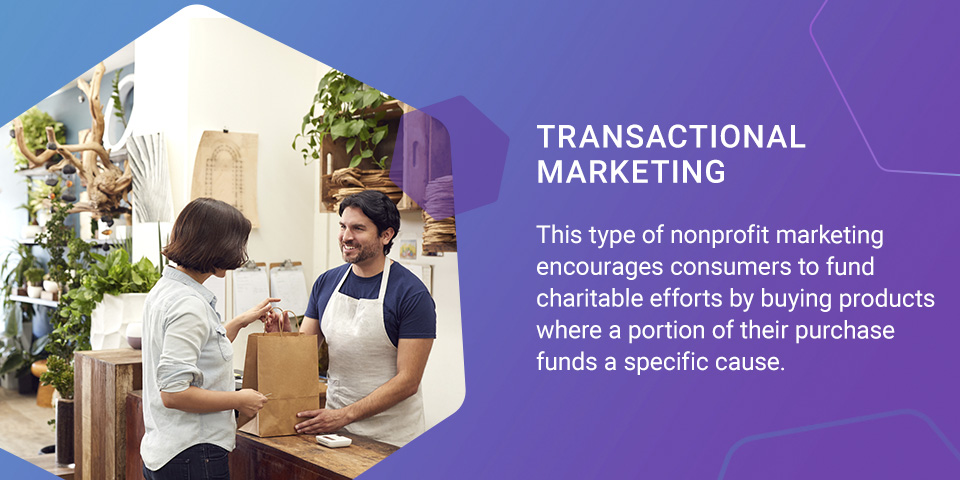Sep 19, 2024
A Quick Guide to Nonprofit Marketing

When you hear the term “marketing,” you likely picture tools and tactics designed to target potential customers and increase revenue from a product or service. While all types of marketing have an end goal of gaining recognition and brand awareness, it looks a little different in the nonprofit world. As a nonprofit organization, you can use marketing strategies to spread the word about your mission.
Whether you want to highlight upcoming fundraisers, attract donors, or find event volunteers, nonprofit marketing is a valuable resource that can help build support for your cause. Nonprofit organizations of any size can benefit from a holistic marketing strategy that establishes new connections and sustains existing relationships with a loyal donor base.
Understanding the different types of nonprofit marketing and their benefits can help you craft a quality marketing approach and successfully carry out your initiatives.
What is a Nonprofit Marketing Plan?
A nonprofit marking plan is a framework that outlines how your organization will carry out activities to advertise your campaigns, programs, services, and events. Any materials or media you use to support your nonprofit's message is called marketing collateral, which could include brochures, newsletters, press releases, videos, and much more. Marketing collateral is just one piece of a comprehensive nonprofit marketing plan that helps fundraising teams and volunteers reflect on your mission and hone your existing engagement strategies.
Because your nonprofit relies on donations to operate, you can use marketing techniques to get your organization on the map and potentially gain more supporters. Increased awareness can lead to increased donations, helping you perform your most critical initiatives and missions. Marketing for nonprofits is one of the most effective ways to attract new supporters and communicate with existing donors and team members.
A nonprofit marketing plan typically includes:
- An executive summary of expected results
- Assigned staff roles
- Consistent messaging and positioning
- Plans for individual projects
- Brand guidelines
- A defined target audience
- A description of campaign goals and aligned activities
- Detailed donor data
- Competitor marketing research
- Clear, actionable goals
- Strategies for increasing donor engagement
When developing a nonprofit marketing plan, ask yourself the following questions:
- Who are we targeting?
- What is our audience's preferred method of contact?
- What imagery, messaging, and colors are consistent with our branding?
- What is our promotions budget?
- What marketing channels will we use?
- What specific tasks and roles can our team members take on?
- How do we measure our progress and stay on track with our goals?
- Which of our past marketing campaigns were the most successful? Why?
- What marketing strategies best support our overall priorities?
- What motivates our donors?
- What type of marketing collateral should we create?
- Where will we share content?
For-profit and nonprofit organizations have some similarities, but their marketing methods are distinct. For-profit marketing generally focuses on encouraging customers to buy a product that will benefit them. Alternatively, nonprofit marketing usually aims to build awareness of a cause or issue to encourage people to give. Instead of receiving a product or service as in a for-profit transaction, nonprofit audiences give their funds in exchange for philanthropic benefits.
Types of Nonprofit Marketing
As with for-profit marketing, nonprofit marketing can take many shapes and forms. Although these marketing strategies have similar goals for increasing donations, volunteer participation, and mission awareness, implementing each one looks slightly different.
Here are some examples of nonprofit marketing campaigns:
- Point-of-sale marketing: Attract donors who are already in the mindset of giving funds. Point-of-sale marketing supports your nonprofit campaign by asking individuals to donate to your cause or round up their purchase amount during the checkout process.
- Transactional marketing: If you partner with a corporate donor, you can design a transactional campaign. This type of nonprofit marketing encourages consumers to fund charitable efforts by buying products where a portion of their purchase funds a specific cause. This produces positive publicity for both partners.

- Message-focused marketing: Driving awareness is a key element of message-focused campaigns. Nonprofits encourage consumers to take action or prompt behavioral changes to spread the word about a cause. This strategy is tied to fundraising efforts and high-profile current events.
- Social media marketing: Social platforms are a key place to attract potential donors by sharing information on upcoming events or promoting your nonprofit's mission. Social media marketing can include connecting directly with followers, enabling easy access to fundraising tools, demonstrating your work, and creating shareable content that enables users to spread the word.
Benefits of Marketing for Nonprofits
What exactly can nonprofit marketing do for your organization? These are some key benefits you can gain from implementing a comprehensive marketing strategy:
- Raise awareness: Nonprofit marketing is simple — donors can't give funds if they don't know your nonprofit exists. Your marketing strategy spreads the word about your cause and mission and helps attract like-minded individuals who want to support your nonprofit through donations or volunteer participation. Increased awareness also helps build a positive reputation and gain traction in the charitable sector.
- Increase donations: Marketing and fundraising are two sides of the same coin that empower you to do more for your cause. Developing a nonprofit marketing plan with engaging content and messaging lets potential donors know you need help to fund your mission.
- Drive donor memberships: Establishing and sustaining strong donor relationships builds loyalty within your nonprofit. If you want to increase recurring donations and donor memberships, a well-designed marketing plan can help you keep your supporters updated and remind them why they stand behind your organization.
- Attract and recruit volunteers: Funding is a significant component of nonprofit marketing, but volunteers are the core of any nonprofit organization. Volunteers contribute time, energy, expertise, and even donations to nonprofits because they believe in the mission. Effective nonprofit marketing can help you attract and recruit volunteers who want to support a cause they're passionate about — and it just might be yours.
- Enhance your digital presence: Today, many donors and individuals communicate and search for topics through digital channels. A well-developed marketing plan can ensure your nonprofit addresses the most popular platforms and channels for keeping in touch with supporters, such as text, email, social media, phone, or physical media. Additionally, having a strong presence online can build trust with potential donors and put your nonprofit on the map in your community.
Maximize Your Nonprofit Marketing Strategy with GiveSmart
Nonprofit marketing is a powerful tool your organization can use to reach your demographic and make a bigger impact. If you want to grow your cause, consider taking a comprehensive approach to your marketing plan. At GiveSmart, we've developed seamless solutions that help nonprofits and charitable organizations connect with their audience in new ways.
Our fundraising event management software can consolidate time-consuming tasks and help you standardize your marketing practices. It's our goal to help you access the right tools and channels to entice sponsors and increase donations to your cause. Learn how we can help your organization reach its goals by requesting a demo today!
Related




